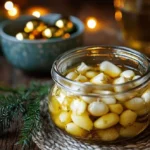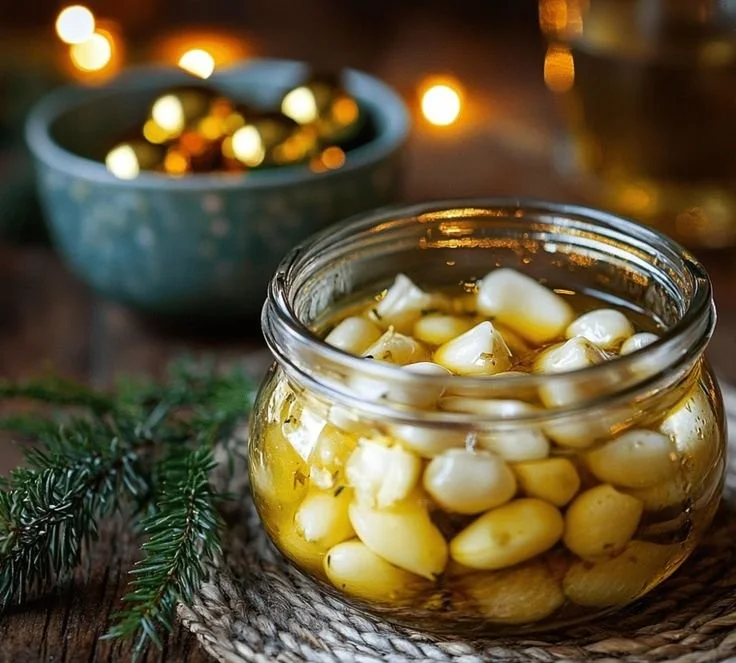Why Does My Pickled Garlic in Olive Oil Keep Softening?
Pickled garlic in olive oil is a delightful addition to many dishes, adding a punch of flavor and a hint of sweetness. However, if you’ve noticed your pickled garlic softening over time, you’re not alone. I’ve made my share of pickled garlic at home, experiencing both successes and a few softening mishaps. Let’s dive in to uncover the reasons behind this, so you can enjoy your pickled garlic at its best!
Why Make This Recipe
- Flavor Boost: Pickled garlic infuses dishes with a tangy, garlicky punch that can elevate salads, pasta, and meats.
- Health Benefits: Garlic is known for its antibacterial properties and potential cardiovascular benefits, making this a nutritious option for flavoring your meals.
- Versatility: This recipe can easily be adapted for different cuisines, making it perfect for various dishes at home.
- Convenient Storage: When properly stored, pickled garlic can last for weeks, adding readily available flavor to your pantry.
- Personally, I love making this recipe as it allows me to preserve garlic seasonally and enjoy its distinct flavor throughout the year.
Recipe Overview
- Prep Time: 15 minutes
- Cook Time: None
- Total Time: 24 hours (for marinating)
- Servings: Makes about 2 cups
- Difficulty Level: Easy
- Cooking Method: No cooking required; it’s an infusion process.
My Experience Making This Recipe
In my kitchen trials, I’ve had both successes and hiccups while perfecting my pickled garlic. One of the key lessons was discovering the importance of the oil quality—extra virgin olive oil definitely stands out for flavor. I also learned that if the garlic isn’t stored properly, it can soften and lose that delightful crunch, which is not what you want when enjoying a pickle.
How to Make Pickled Garlic in Olive Oil
Making pickled garlic in olive oil is straightforward. Start by peeling fresh garlic cloves and placing them in a sterilized glass jar. Next, fill the jar with quality extra virgin olive oil, ensuring the cloves are completely submerged. Add any desired herbs or spices such as rosemary, thyme, or red pepper flakes for an extra flavor kick. Seal the jar tightly and let it sit in a cool, dark place for 24 hours to allow the flavors to meld.
Expert Tips for Success
- Use Fresh Garlic: Always opt for fresh, firm garlic. The fresher the garlic, the better the final product will taste and hold its texture.
- Sterilize Jars: Ensure your jars are well sterilized to prevent bacterial growth, which can lead to spoilage.
- Oil Quality Matters: Choose a high-quality extra virgin olive oil for the best flavor. The oil is just as much an ingredient as the garlic itself.
- Submerge Completely: Make sure all garlic cloves are fully submerged in oil to avoid air pockets, which can lead to softening.
- Monitor Storage: Store in a cool, dark place and consume within 1 to 2 months for optimum flavor and texture.
How to Serve Pickled Garlic in Olive Oil
- Antipasto Platters: Serve your pickled garlic alongside olives, cheeses, and cured meats for an exciting appetizer.
- Savory Salads: Chop the garlic and toss with your favorite salad greens, adding a tangy twist to dressings.
- Pasta Dishes: Incorporate whole garlic cloves into pasta dishes for added depth; they become wonderfully sweet after marinating.
- Sandwich Garnish: Use sliced pickled garlic as a zesty topping on sandwiches or burgers for an extra kick.
Storage and Reheating Guide
Store your pickled garlic in an airtight jar in the refrigerator for up to 1 to 2 months. Make sure the garlic remains submerged in oil. If the oil solidifies in the fridge, simply let it sit at room temperature until it returns to liquid form. Avoid freezing as this can alter the texture of the garlic significantly.
Recipe Variations
- Herb-Infused: Experiment with different herbs, such as dill or basil, to create unique flavor profiles.
- Spicy Twist: Add crushed red pepper flakes or sliced chili peppers for a spicier version.
- Sugar Addition: A small amount of sugar can add a hint of sweetness, balancing the acidity perfectly.
- Vinegar Addition: For a tangier taste, consider adding a splash of vinegar along with the oil.
Nutritional Highlights
Pickled garlic is low in calories and contains antioxidants that may help support overall health. It can be a great option for those following a vegan or gluten-free diet. However, it’s important to note that those with a garlic allergy should avoid this recipe.
Troubleshooting Common Issues
- Garlic Softening Too Much: If your garlic is becoming too soft, ensure it remains fully submerged in oil and check the quality of the garlic used.
- Off-Flavors Developing: If you notice any off-flavors, it could be from inadequate sterilization or unexpected contaminants. Always use clean utensils and jars.
- Cloudy Oil: Cloudiness can occur as the garlic releases some moisture. As long as there’s no off-odor or spoilage, it’s generally safe to consume.
Frequently Asked Questions
-
Can I use different types of oil?
Absolutely! While olive oil is preferred for its flavor, you can experiment with other oils like grapeseed or avocado oil, keeping in mind that they will alter the taste. -
How can I tell if my pickled garlic has gone bad?
Look for signs of spoilage such as off smells, unusual texture, or mold. If in doubt, it’s best to discard it. -
How do I know how much garlic to use?
A general rule is to use about 2 cloves of garlic for every cup of oil. Adjust based on your taste preference. -
Is it safe to consume garlic preserved in oil?
Yes, as long as it is properly prepared and stored. Monitor for any signs of spoilage, especially if left at room temperature for any length of time.

Pickled Garlic in Olive Oil
- Total Time: 1440 minutes
- Yield: 2 cups
- Diet: Vegan
Description
A delightful infusion of garlic in olive oil that adds a tangy flavor boost to your dishes.
Ingredients
- Fresh garlic cloves
- Extra virgin olive oil
- Herbs or spices (e.g., rosemary, thyme, red pepper flakes)
Instructions
- Peel fresh garlic cloves and place them in a sterilized glass jar.
- Fill the jar with quality extra virgin olive oil, ensuring the cloves are completely submerged.
- Add any desired herbs or spices for extra flavor.
- Seal the jar tightly and let it sit in a cool, dark place for 24 hours.
Notes
Ensure jars are well sterilized to prevent bacterial growth. Store in a cool, dark place and consume within 1 to 2 months for the best texture.
- Prep Time: 15 minutes
- Cook Time: 0 minutes
- Category: Condiment
- Method: Infusion
- Cuisine: Mediterranean

